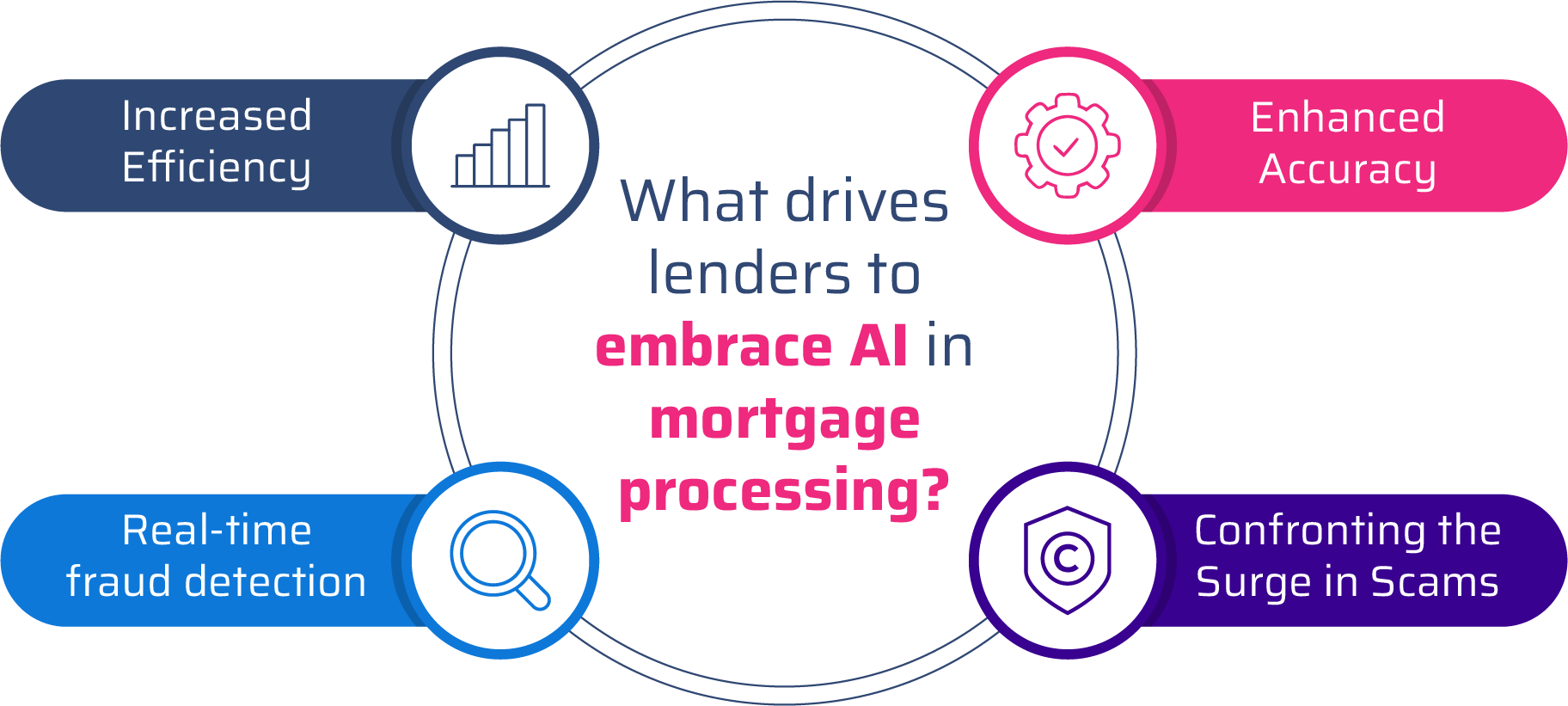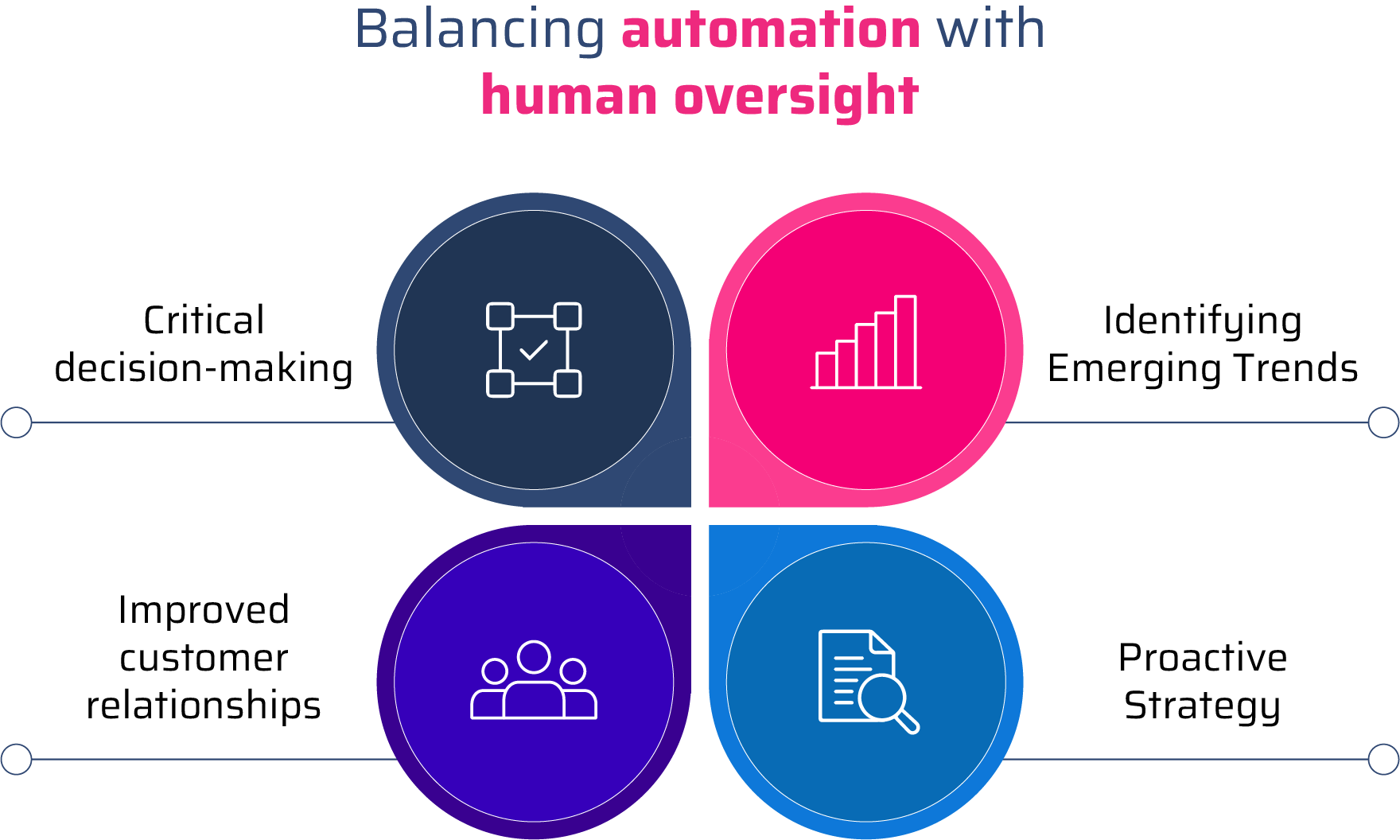
Listen to this blog
Introduction
The United States mortgage industry is experiencing a transformative shift as it adopts GenAI-driven digital transformation to address complex operational challenges and meet the increasing expectations of tech-savvy consumers. This evolution underscores the industry's commitment to innovation and efficiency in a competitive market. The Federal National Mortgage Association highlights that nearly 47% of mortgage lenders in United States have integrated GenAI-powered solutions to enhance efficiency in loan processing. This trend reflects a growing commitment within the industry to leverage advanced solutions streamlined operations.

What drives lenders to embrace AI in mortgage processing?
Manual workflows and labor-intensive verifications are being transformed through the adoption of Gen AI. These advanced solutions automate the key tasks, such as mortgagor’s background verification and conducting detailed credit assessments. By reducing errors, improving efficiency, and accelerating critical processes, Gen AI enables lenders to enhance risk management while offering a seamless experience for borrowers.

Modern advancements in technology are enabling lenders to achieve unprecedented levels of operational efficiency, reducing processing time by up to 50%. This improvement is not merely about speed, it reflects more structured and reliable approach to managing the complexities of mortgage workflows. By minimizing bottlenecks, enhancing accuracy, and reducing manual interventions, lenders can allocate resources more effectively and focus on delivering a superior borrower experience.

Intelligent credit assessment tools offer great precision in evaluating borrowers by leveraging extensive datasets and advanced analytics. This approach minimizes manual errors, providing lenders with a more comprehensive understanding of a borrower’s creditworthiness. By incorporating diverse data points and automating complex calculations, these innovative platforms not only reduce inaccuracies but also improve approval rates by up to 30%. This level of accuracy fosters trust among stakeholders and enhances the overall reliability of lending decisions, setting a new benchmark for data-driven mortgage operations
Fraud Prevention in the Mortgage Industry
Mortgage application fraud has become an escalating concern in the United States, as fraudsters exploit vulnerabilities in traditional verification methods. The Federal Trade Commission has reported losses exceeding $1.6 billion due to mortgage-related identity frauds, highlighting the need for robust security measures. Fraudulent applications not only result in significant financial losses but also compromise the accuracy of creditworthiness evaluations, posing increased risks to lenders. To overcome these challenges, advanced solutions are being deployed to detect anomalies, cross-reference borrower data in real time, and promptly identify inconsistencies or suspicious activities, ensuring greater security and reliability in mortgage processing.
Advanced tools such as Intelligent Character Recognition (ICR) and Intelligent Document Processing (IDP) enable instant verification of borrower identities by analyzing extensive datasets from multiple sources. These solutions enhance the accuracy of fraud detection, identify inconsistencies, and strengthen the end-to-end security of the mortgage processes.
The rise in mortgage application scams poses a significant threat to lenders, as fraudsters employ sophisticated tactics to exploit gaps in verification processes. These scams often involve falsified documents, stolen identities, and manipulated financial information, leading to financial and reputational risks. By implementing advanced fraud detection systems, lenders can proactively identify discrepancies, validate borrower authenticity, and mitigate exposure to fraudulent applications. Strengthening these defenses is critical in maintaining trust and security within the mortgage ecosystem.

Balancing Automation with Human Oversight
As the mortgage industry evolves, automation has redefined efficiency, empowering lenders to manage high volumes and reduce turnaround times. Yet, no technology can fully replicate the critical thinking, adaptability, and accountability that human oversight brings to the table. While automated systems excel in handling routine tasks such as data processing, document validation, and preliminary evaluations, human professionals play an irreplaceable role in interpreting complexities, making nuanced decisions, and managing exceptions that fall outside predefined algorithms.
A well-orchestrated balance between automation and human expertise is not merely a best practice—it is essential in navigating the intricate and heavily regulated mortgage landscape. This dual approach ensures that while processes are streamlined for efficiency, they also uphold rigorous quality standards, minimize compliance risks, and address unique borrower needs.
Human oversight provides the ability to navigate complex scenarios with contextual understanding and critical thinking that technology cannot replicate. This ensures that nuanced decisions are handled with precision, care, and expertise, maintaining the integrity and reliability of the mortgage process.
While advanced tools streamline operations and automate routine interactions, human engagement remains essential for addressing individualized customer concerns, fostering trust, and creating meaningful connections. This personalized approach enhances satisfaction and reinforces loyalty in a competitive lending environment.
Forecasting Market Shifts and Consumer Demands
Advanced algorithms have the capability to analyze vast datasets, including historical sales records, social media activity, consumer behavior patterns, and economic indicators, to forecast emerging market trends and shifts in consumer preferences. A report by McKinsey highlights that businesses leveraging these predictive tools can reduce demand forecasting errors by up to 50%. Accurate demand prediction enables organizations to better align their product offerings with customer expectations, ensuring timely delivery while avoiding inventory shortages or surpluses.
Advanced analytics tools gather insights from diverse sources, including sales data and consumer behavior patterns, to deliver a comprehensive view of shifting market dynamics. This enables businesses to identify and adapt to emerging trends, ensuring they remain responsive to evolving customer demands.
By forecasting market changes, organizations can refine their product offerings and adjust business strategies ahead of time. This forward-thinking approach not only strengthens their competitive position but also ensures a closer alignment with consumer preferences and expectations.
Enhancing Security with Advanced Data Encryption Methods
As advanced technologies become deeply embedded in the mortgage industry, safeguarding borrower data has become a critical priority. Financial records and personal identification details are increasingly exposed to risks of unauthorized access without robust security measures in place. The growing prevalence of cyber threats underscores the need for implementing advanced encryption protocols to mitigate the risk of data breaches. Intelligent systems play a vital role in bolstering data security. Real-time monitoring and anomaly detection enable lenders to identify and respond to potential threats swiftly, minimizing vulnerabilities. By integrating cutting-edge encryption techniques with sophisticated threat detection capabilities, lenders can create a secure environment that protects borrower information and upholds trust in the ever-evolving digital mortgage landscape.
Advanced monitoring systems provide continuous oversight of data access, swiftly detecting any irregular activities that could indicate potential security breaches and enabling proactive risk mitigation.
Robust encryption frameworks ensure that even if data is intercepted, it remains secure and inaccessible without the appropriate decryption credentials, safeguarding sensitive borrower information from unauthorized access.
Conclusion
The mortgage industry is undergoing a profound transformation, driven by the adoption of digital innovations to overcome operational challenges and meet evolving customer expectations. Processes once reliant on manual tasks and extensive paperwork are now being redefined through automation, streamlining key stages of mortgage origination. As lenders navigate this shifting landscape, the integration of advanced technologies is becoming a cornerstone of progress, fostering greater efficiency and adaptability. Looking forward, the industry is poised to see continued advancements in automation, data-driven insights, and digital-first solutions. These developments pave the way for a fully digitized mortgage ecosystem, enhancing responsiveness, reducing complexities, and delivering a seamless experience for borrowers and stakeholders alike.




